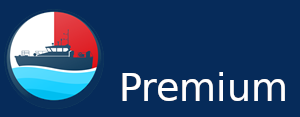Video Presentation of manned ship models at Port Revel Shiphandling Training Centre
published on 24 October 2019
Port Revel is used for shiphandling training of maritime pilots, masters and officers on a 5 ha lake with 11 manned model ships representing 20 vessels, and 4 tugs at scale 1:25 and DGPS tracking system. Instructors are former maritime pilots.
Training on the scale models provides experience that could never be gained on real ships for the simple reason that neither ship-owners nor local authorities would allow such risks to be taken. Scale models allow the shiphandler to make mistakes....
Video New podded cruise ship at Port Revel
published on 24 October 2019
Video Very descriptive: Piston Effect when entering lock.
published on 10 May 2020
Two new locks were introduced in 2009 for training in the new Panama lock conditions with or without tug(s). This video shows the famous "piston effect" when entering the lock at an impressive speed of 10 knots with a high blockage factor.
Port Revel provides shiphandling training using manned models for maritime pilots, masters and officers: http://www.portrevel.com
Article Predicting Maritime Pilot Selection with Personality Traits
by Marine-Pilots.com - published on 7 July 2021
Video Serious Injury to Pilot video by Maritime Training Services
published on 13 December 2019
Video Maneuvering information onboard - Pilot Card, Wheelhouse Poster and ...
published on 14 July 2020
This video explains the IMO resolution on the provision and display of maneuvering information on board ships, particularly the pilot card, wheelhouse poster and maneuvering booklet. the layout and contents of each are explained as well. Contents of this video will benefit mariners preparing for exams (written and oral examinations). Mariners will also benefit by watching the following videos: Duties of the SAR mission coordinator: https://youtu.be/9J3q6XczIGE Duties of the on-scene...
Video Discussion on Wind effect - drifting with no propulsion, only thrusters
published on 11 July 2020
Video Shiphandling: Pivot Point and Transverse Thrust
published on 22 May 2022
Video IRAGO 11 PILOT BOAT
published on 13 March 2023
IMO: - Name: IRAGO 11 PILOT BOAT Vessel Type - Generic: Pilot Vessel Vessel Type - Detailed: Pilot Vessel Navigational Status: Active MMSI: 431003419 Call Sign: - Flag: Japan [JP] Gross Tonnage: - Summer DWT: - Length Overall x Breadth Extreme: 18 x 4 m Year Built: - Home Port: - https://www.marinetraffic.com/en/ais/details/ships/shipid:661579/mmsi:431003419/imo:0/vessel:IRAGO_11_PILOT_BOAT

